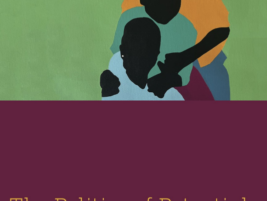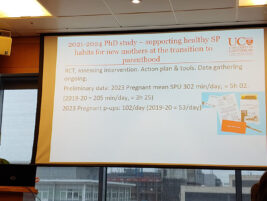The recently published German AWMF guideline‚ ‘Mental Health Disorders in Infancy, Toddlerhood, and Preschool Age‘ represents some advancement in the diagnosis and treatment of mental health in children up to the age of five, particularly since the internationally widely used DC 0-5 (2016) has not yet been included as the standard for under fives into German diagnostic classification systems.
The German AWMF system provides evidence-based guidelines for diagnostic and treatment developed by the Institute for Medical Knowledge Management (IMWi) and the Association of the Scientific Medical Societies (AWMF). It is similar to the internationally reknowned NICE guidelines, developed by The National Institute for Health and Care Excellence (NICE) in the UK. NICE provides several guidelines pertinent to Infant Mental Health, focusing on the social and emotional wellbeing of children under five (2025). These guidelines provide evidence-based recommendations for professionals involved in early years’ care.
This commentary describes the major changes to the guidelines, a brief description of ongoing limitations and perspectives for a future revision.
The AWMF Guideline on Mental Health Disorders in Infants, Toddlers, and Preschool Children
The AWMF guideline on mental health disorders in infancy, early childhood, and preschool age focuses on children aged 0 to 5 years 11 months. It provides evidence-based recommendations for the diagnosis and treatment of mental health disorders in young children. The primary aim is to offer a practice-oriented approach for all professionals working with this age group, including child and adolescent psychiatrists and psychotherapists, pediatricians, midwives and family nurses, physio-, occupational and speech therapists etc.
The guideline emphasizes the importance of early detection and intervention to prevent chronic conditions and long-term impairments. It considers the high developmental dynamics in this age group and the crucial role of primary caregivers. Recommendations cover both diagnostic procedures and therapeutic approaches tailored to the specific needs of children under six years of age. Unfortunately there is no English translation nor an English summary.
This newly published guideline is an update of the 2015 published version and was developed through an interdisciplinary process involving diverse professionals working with under fives and is based on recent scientific evidence.
The preamble and those chapters particularly relevant to very young children, such as Relationship Disorders, Regulatory Disorders (as separate from Sensory Disorders), Early Childhood Feeding and Eating Disorders were revised in order to secure a more relational focus on development, classification and treatment of disorders from 0 – 3 years of age.:
- A new developmental-phase-specific order of disorders was introduced and chapters on specific disorders were restructured.
- Relationship Disorders as a Central Chapter in the very beginning of the guidelines: The guideline dedicates a separate chapter to relationship disorders, highlighting the importance of early parent-child interactions for the child’s emotional and psychological development and integrating a relationship-focused understanding of disorder development and treatment—especially for children aged 0–3 years.
- Early Childhood Regulatory Disorders as an Independent Category: Regulatory Disorders as described by Asmussen et al. (2023), Chatoor (2005, 2009), von Hofacker (1998), Papoušek (2004), Ziegler et al. (2023) such as excessive crying, sleep disturbances, and feeding difficulties are recognized as a distinct category of disorders and a chapter of its own, enabling more targeted diagnostics and treatment. This is of outmost clinical relevance as regulatory disorders tend to generalize and affect several regulative capacities as well as persist, and are therefore highly disturbing for parents. The critical revision placed great importance on ensuring alignment with DC:0-5 (2016, 2019) and current clinical research, while also preserving the German concept of Early Childhood Regulatory Disorders and distinguishing it from the internationally widely recognized diagnosis of ‘Sensory Processing Disorders’.
- The chapter on eating disorders was renamed ‘Feeding and Eating Disorders’, and the clinically and therapeutically relevant classification of early childhood feeding disorders by Irene Chatoor (2009), which used to be included in the DC:0-3R (2005), was reinstated in the diagnostics, classification, and treatment recommendations. Irene Chatoor’s classification of feeding disorders has proven to be highly useful in clinical practice as Chatoor identifies different types of feeding disorders, including infantile anorexia and sensory food aversion, and provides specific diagnostic criteria as well as therapeutic approaches for each category. This differentiation allows professionals to develop a precise understanding of the psychosomatics and psychodynamics in order to develop individually tailored interventions.
- The inclusion of psychodynamic interventions to working with parents and infants.
Limitations of the Guidelines
The revised German guidelines now provide users working with infants, toddlers, preschoolers and their parents with insight into some of the relational and psychodynamic aspects with regard to disorder development, diagnostics, and treatment. However, unlike the NICE guidelines on ‘Social and Emotional Health’ and ‘Promoting Wellbeing’ the German guidelines focus by definition on the impairment of health and wellbeing and on defining disorders instead of focusing on supporting health and wellbeing and the development of a positive bonding and attachment relationship. This is partly due to the different wording in English and German languages but also a focus on to Mental Health and wellbeing in English speaking countries and on mental disorders in German speaking countries.
Future Perspectives
There is still a long way to go until not only the German guidelines but also healthcare, social services and early education really focus on the relational nature of the Early Years. The lack of attention to the family system and, in particular, to the infant during this key developmental phase ultimately leads to exorbitantly high follow-up costs for both the healthcare system and social security systems (Campbell et al., 2014; Heckman, 2005). Even more so against the backdrop of existential crises that urgently require early intervention.
At least for the first 1001 days from pregnancy to the child’s second birthday a timely, individually tailored, multi-level classification and intervention for the baby and parents is not only urgently needed (NICHD, WHO, WAIMH, Young Minds) but also cost-effective (Heckman, 2005). An intervention that takes into account the child’s uninterrupted brain development, the attachment process completed by the end of the second year, and the parents’ mental health.
References
Asmussen J, Davidsen KA, Olsen AL, Skovgaard AM, Bilenberg N (2023) The longitudinal association of combined regulatory problems in infancy and mental health outcome in early childhood: a systematic review. Eur Child Adolesc Psychiatry. doi: 10.1007/s00787-023-02262-0. Epub ahead of print.
Bindt C, von Gontard A, Möhler C, Agel L, Borg-Laufs M, Caby A, Frank E, Haas CR, Hentschel G, Hommel S, Kapaun P, Klein E, Koester-Lück M, Metge C, Oelkers-Ax R, Rahlf A, Reuner G, Schimansky G, Scholz S, Thies A, Trollmann R, von Kalckreuth B, Watson M, Ziegler M. (in Vorbereitung) Leitlinien Psychische Störungen im Säuglings-, Kleinkind und Vorschulalter, AWMF. https://register.awmf.org/de/leitlinien/detail/028-041
Campbell, F., Conti, G., Heckman, J.J., Moon, S.H., Pinto, R., Pungello, E., & Pan, Y. (2014). Early childhood investments substantially boost adult health. Science, 343(6178), 1478-1485.
Chatoor, I. (2005). Diagnosis and Treatment of Feeding Disorders in Infants and Toddlers. In: Diagnostic classification of mental health and developmental disorders of infancy and childhood: Revised edition (DC: 0–3R). Washington, D.C.: ZERO TO THREE Press.
Chatoor, I. (2009) Diagnosis and Treatment of Feeding Disorders in Infants, Toddlers and Young Children. Washington DC: Zero to Three.
Heckman, J.J. (2005). Skill formation and the economics of investing in disadvantaged children. Science, 312(5782), 1900-1902. doi:10.1126/science.1128898.
Hofacker, N. von (1998). Early childhood disorders of behavioral regulation and the parent-child relationship. In von Klitzing (Ed.), Psychotherapy in early childhood (pp. 77–110). Vandenhoeck & Ruprecht.
NICE (2012). Social and emotional wellbeing: early years. Public health guideline [PH40] Published: 24 October 2012. Retrieved from: https://www.nice.org.uk/guidance/ph40. 25th of Feb 2025.
NICE (2016). Early years: promoting health and wellbeing in under 5s. Quality standard [QS128] Published: 11 August 2016. Retrieved from: https://www.nice.org.uk/guidance/qs128. 25th of Feb 2025.
NICE (2020). Antenatal and postnatal mental health: clinical management and service guidance. Clinical guideline [CG192] Published: 17 December 2014 Last updated: 11 February 2020. Retrieved from: https://www.nice.org.uk/guidance/cg192. 25th of Feb 2025
Papoušek, M. (2004). Regulatory disorders in early childhood: Clinical evidence for a new diagnostic concept. In M. Papoušek, M. Schieche, & H. Wurmser (Eds.), Regulatory disorders in early childhood: Early risks and interventions in the developmental context of parent-child relationships (pp. 77–110). Huber.
Parent Infant Foundation (2023). https://parentinfantfoundation.org.uk/powerful-mums-survey-results-launched-to-mark-start-of-infant-mental-health-awareness-week-2023
Royal College of Psychiatrists (2023) College Report CR238 – Infant and early childhood mental health: the case for action.
World Association for Infant Mental Health. (2016). Position paper on the rights of infants. Paper presented at the 14th World Association for Infant Mental Health Congress, Edinburgh, Scotland. Retrieved from https://www.waimh.org/i4a/pages/index.cfm?pageID=3361
World Health Organization (2013). The importance of caregiver-child interactions for the survival and healthy development of young children: A review. Geneva, Switzerland: World Health Organization.
ZERO TO THREE. (2016). Diagnostic classification of mental health and developmental disorders of infancy and childhood (DC: 0–5). Washington, D.C.: ZERO TO THREE Press.
ZERO TO THREE. (2019). DC: 0–5. Diagnostic classification of mental health and developmental disorders of infancy and early childhood. German Translation. Stuttgart: Kohlhammer.
Ziegler, M., Wollwerth de Chuquisengo, R., Mall, V., & Licata-Dandel, M. (2023). Early childhood mental disorders: Excessive crying, sleep and feeding disorders, and interventions using the “Munich model” as an example. Bundesgesundheitsblatt – Gesundheitsforschung – Gesundheitsschutz, 66, 752–760.
Authors
Susanne Hommel,
Germany
Barbara von Kalckreuth,
Germany
Margret Ziegler,
Germany
Corresponding author: Susanne Hommel PhD., Baby Clinic Hamburg, Hamburg, Germany, phd@susannehommel.de








